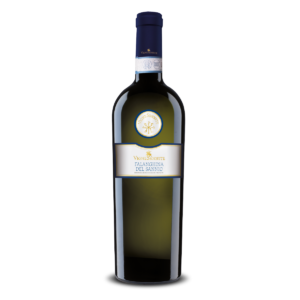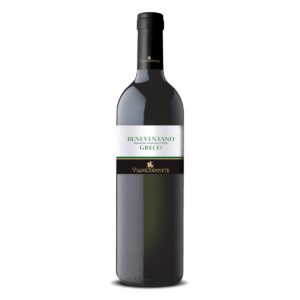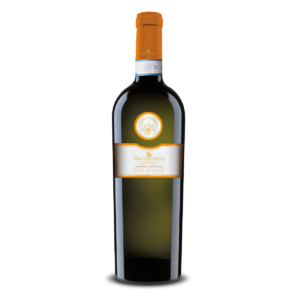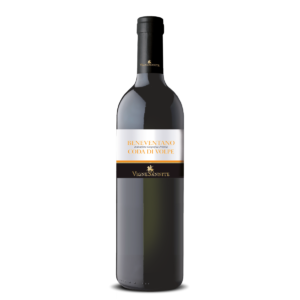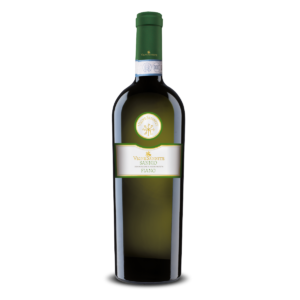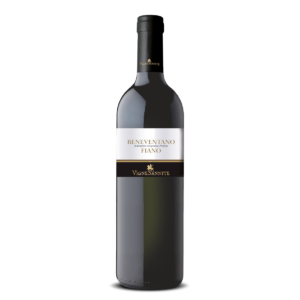Bianchi
Falanghina
- L’UVA. IL VIGNETO. IL TERRITORIO
- La Falanghina, antico vitigno la cui presenza nel Sannio
risale agli inizi del 1800, prende il nome dal
sostantivo latino “Falanga” – palo di sostegno
della vite – e trova nel Sannio il suo habitat
ideale caratterizzato da forti escursioni
termiche.Sono particolarmente diffusi due cloni, Falanghina verace e Falanghina
mascolina, che opportunamente vinificati
esaltano le peculiarità del vitigno. Uva a bacca
bianca con un grappolo medio gemellato,
germogliazione precoce e maturazione
completa tra fine Settembre e inizio Ottobre. - IL VINO
- Il vino ottenuto da uva Falanghina ha un colore
giallo paglierino con caratteri di complessità
aromatiche, sentori di frutta bianca matura e foglie di salvia, al gusto é fresco, sapido e minerale. Vino ideale per accompagnare
antipasti a base di pesce ed in particolare
crudo e grigliate. Consigliamo di servirlo ad una temperatura di 8°C. - LA VINIFICAZIONE
- Dopo una attenta cernita nei vigneti, le uve vengono conferite nell’enopolio
ove subiscono una pigio-diraspatura soffice con
aggiunta di ghiaccio secco per effettuare un
primo controllo delle temperature.Segue una fermentazione a temperatura
controllata 13-15°C. Così facendo si ottiene
un prodotto fresco fruttato e aromatico, che
esalta le peculiarità del vitigno e del territorio.
- THE GRAPES AND THE VINEYARD
- This is an ancient grape variety, the presence of which
in Samnium dates to the early 19th century. lt takes its
name from the Latin noun “Falanga” – the stake used to
support the vine – and in Samnium finds its ideal habitat,
characterised by extreme differences in temperature. Two
clones in particular Falanghina verace and Falanghina
mascolina have become widespread and, when correctly
vinified, exalt the specific characteristics of the grape
variety. A white grape with a medium-sized winged
cluster, early budbreak and complete ripening between
the end of September and the beginning of October. - THE WINE
- The wine made from Falanghina grapes is straw yellow
in colour with a characteristic aromatic complexity with
hints of ripe white fruit and sage leaves, fresh sapid and mineral on the palate.It is an ideal wine to accompany fish-based hors
d’oeuvres, especially raw and grilled fish. We
recommend serving at a temperature of 8° C. - VINIFICATION
- After a careful selection of the grapes performed in the
vineyards, they are delivered to the winery where they
undergo soft pressing- destemming and the addition of
dry ice for an initial temperature control. This is followed
by fermentation at a controlled temperature of 13-15° C so as to achieve a fresh, fruity and
aromatic product that enhances the characteristic qualities of the grape variety and the terroir.
Greco
- L’UVA. IL VIGNETO. IL TERRITORIO
- Il nome e le origini del vitigno Greco derivano
dalle viti Aminee gemine, citate anticamente
da Columella, Virgilio e Plinio.Vitigno che trova nel territorio sannita ricco di
minerali il giusto equilibrio per dare origine a
un vino di grande pregio.Uva a bacca bianca con un grappolo piccolo e
gemellare, ha una germogliazione
medio/precoce ed una maturazione nella
seconda/terza decade di Ottobre. - IL VINO
- Il vitigno Greco produce vini di grande
freschezza e mineralità, dal colore giallo
paglierino e brillante, con sentori fruttati di
agrumi, albicocca e pesca, dal sapore morbido,
minerale, strutturato ed elegante.Vino che invita al consumo di cibi dal gusto
deciso, come complessi antipasti, primi
aromatici e secondi di pesce. Consigliamo di
servirlo ad una temperatura di 8°C. - LA VINIFICAZIONE
- Dopo una attenta cernita delle uve effettuate
nei vigneti, vengono conferite nell’enopolio
ove subiscono una pigio-diraspatura soffice ed
aggiunta di ghiaccio secco per effettuare un
primo controllo delle temperature.Segue una fermentazione a temperatura
controllata 13-15°C.. Così facendo si ottiene
un prodotto fresco fruttato e aromatico, che
esalta le peculiarità del vitigno e del territorio.
- THE GRAPES AND THE VINEYARD
- The name and the origins of the Greco grape variety
derive from the Aminee gemine vine, cited in ancient
times by Columella, Virgil and Pliny. It is a grape variety that has found in
the mineral-rich Samnite terroir the perfect balance to give rise to a wine of great prestige. A
white grape growing in small winged clusters, it has a medium early budbreak and ripens in the second/third decade of October. - THE WINE
- The Greco grape variety gives life to wines of great
freshness and mineral quality, of a bright straw yellow
colour, With fruity hints of citrus fruits, apricot and
peach and a soft, mineral, well-structured and elegant
flavounIt is a wine that invites the consumption of foods of
strong flavour, such as complex hors d’oeuvres,
aromatic first courses and fish main courses. We recommend serving at a temperature of 8° C. - VINIFICATION
- After a careful selection of the grapes performed in
the vineyards, they are delivered to the Winery where
they undergo soft pressing-destemming and th
addition of dry ice for an initial temperature control.
This is followed by fermentation at a controlled temperature of 13-15° C.so as to achieve a fresh, fruity and aromatic product that enhances the characteristic qualities of the grape variety and the terroir.
Coda di volpe
- L’UVA. IL VIGNETO. IL TERRITORIO
- II vitigno Coda di Volpe già nominato da Gaio
Plinio Secondo detto Plinio il Vecchio nella
Natura/is Historia e molto antico e diffuso nel
Sannio ed e forse il vino bianco che più di tutti
esalta i caratteri del territorio Sannita.
Uva a bacca bianca, con un grappolo grande
ad acini piccoli e regolari. - IL VINO
- Dal territorio sannita origina questo vino
sapido dal colore giallo paglierino, all‘olfatto
ampio e complesso, con note di frutta bianca
come pera e pesca. Al gusto è secco e minerale.Questo vino ben si abbina a piatti a base
di pesce in genere, elaborati al forno o
alla griglia. Consigliamo di servirlo ad una
temperatura di 8°C. - LA VINIFICAZIONE
- Dopo una attenta cernita delle uve effettuate
nei vigneti, vengono conferite nell’enopolio
ove subiscono una pigio-diraspatura soffice ed
aggiunta di ghiaccio secco per effettuare un
primo controllo delle temperature.
Segue una fermentazione a temperatura
controllata 13-15°C., cosi facendo otteniamo
un prodotto fresco fruttato e aromatico, che
esalta Ie peculiarità del vitigno e del territorio.
- THE GRAPES AND THE VINEYARD
- The Coda di Volpe grape variety, already
mentioned by Gaius Plinius Secundus better known as
Pliny the Elder in his Naturalis Historia, is very ancient
and widespread in Samnium, as well as possibly being
the white wine that more than any other expresses all
the qualities of the region. lt is a white grape
that grows in large clusters of small, regular fruits. - THE WINE
- Originating from the Samnite territory, this
flavoursome wine of straw yellow colour has a broad
and complex perfume, with notes of both white fruit
and pear and peach.
lt is dry and mineral on the palate. lt is a
wine that goes perfectly with fish dishes in
general, either baked or grilled.
We recommend serving it at a
temperature of 8° C. - VINIFICATION
- After a careful selection of the grapes
performed in the vineyards, they are delivered to the
Winery where they undergo soft pressing-destemming
and the addition of dry ice for an initial temperature
Fiano
- L’UVA. IL VIGNETO. IL TERRITORIO
- Il vitigno Fiano viene nominato da Plinio il
Vecchio che accosta l‘origine del nome alle
Vitis Apiane, cosi dette poiché preferite delle
api. Il Sannio Fiano DOP e abbastanza diffuso
in questo territorio che con la sua morfologia
ele escursioni termiche ne esaltano le qualità
e le caratteristiche. Uva a bacca bianca dal
grappolo piccolo e con acini croccanti. - IL VINO
- Il vino prodotto con uve Fiano esprime grande
finezza di aromi e complessità gustativa.
Ha un colore giallo paglierino con profumi
dolci di fiori bianchi, al gusto presenta sentori
di pera e frutta sciroppata che lo
rendono l’ideale abbinamento
per piatti ricchi di aromi e strutturati.Il Fiano e un vino che si presta bene
all’invecchiamento e alcune sue caratteristiche
si esaltano anche dopo due anni. Consigliamo
di servirlo ad una temperatura di 8°C. - LA VINIFICAZIONE
- Dopo una attenta cernita delle uve effettuate
nei vigneti, vengono conferite nell’enopolio
ove subiscono una pigio-diraspatura soffice ed
aggiunta di ghiaccio secco per effettuare un
primo controllo delle temperature.Segue una fermentazione a temperatura
controllata 13-15°C., così facendo otteniamo
un prodotto fresco fruttato e aromatico, che
esalta le peculiarità del vitigno e del territorio.
- THE GRAPES AND THE VINEYARD
- The Fiano grape variety is mentioned by Pliny
the Elder, who relates the origin of the name to the
Vitis Apiane, so-called because it was the favourite of
the bees. The Sannio Fiano DOC is fairly widespread
in this terroir, which features a morphology and
extremes of temperature that enhance its qualities
and characteristics. It is a white grape that grows in
small bunches of crunchy fruits. - THE WINE
- The wine made with Fiano grapes expresses an
extraordinary refinement of aromas and complexity of
flavour. It is straw yellow in colour, with the sweet
perfumes of white flowers; on the palate it reveals
hints of pear and fruit in syrup that make it the
perfect accompaniment for aromatic, structured
dishes. The Fiano is a wine that lends itself well to
ageing, and certain characteristics are
enhanced even after two years. We recommend serving
it at a temperature of 8° C. - VINIFICATION
- After a careful selection of the grapes performed in the vineyards, they are delivered to the
winery where they undergo soft pressing-destemming
and the addition of dry ice for an initial temperature
control.This is followed by fermentation at a controlled temperature of 13-1 5° C so as to
achieve a fresh, fruity and aromatic product that enhances the characteristic qualities of
the grape variety and the terroir.


